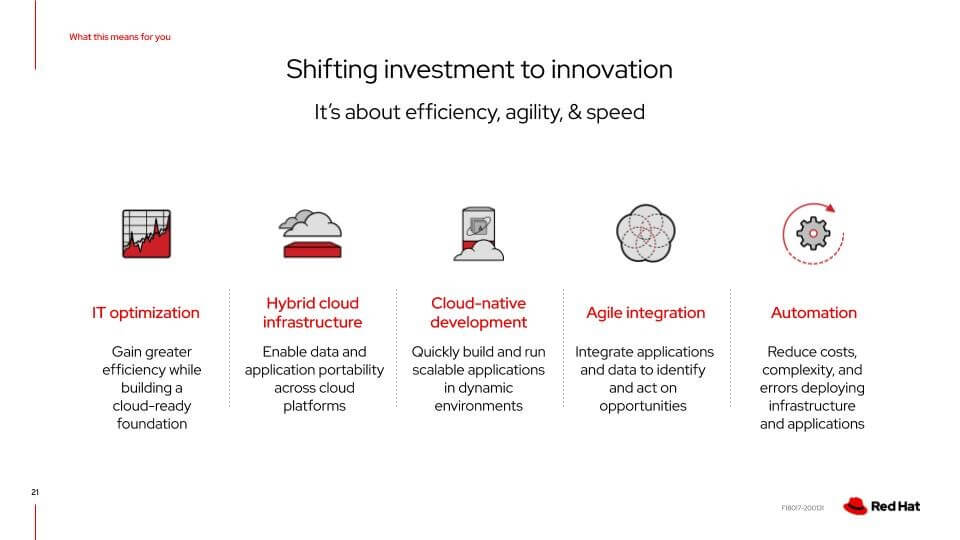
Hybrid or multi-cloud and the people who decide: the Red Hat transformation difference

While it seems odd that a company can make money by selling something apparently available for free, Red Hat certainly sets the bar high for its fellow open-source organizations by ensuring FOSS products can be used reliably and safely in enterprise environments. Bought by IBM in July 2019 for US$34 billion, it was a significant pivot point for Big Blue’s transition to a cloud & services provider with substantial global weight.
And despite the FOSS (free and open-source) community’s initial misgivings (would big business make great swathes of community-developed solutions into proprietary licensed products, for instance?), IBM’s continued funding of Red Hat and the latter’s evident independence has given the business community a killer combination: an enterprise mentality and the bankroll to match, and a huge community of developers actively involved in perfecting software solutions and continually innovating.
The continuity necessary for digital transformation
For the cloud-native business that’s fully-conversant in all things technology, it’s not such a giant leap of faith to undertake a continuous transformation process. Likewise, the culture of ongoing development and continuous integration from DevOps seems to be only a natural progression for the rest of the enterprise: a shift to an agile, open and proactive footing from one that rigidly sticks to its long-term plans, come hell or high water.
But for many companies, transitioning to the cloud — and all it has to offer — is not a simple process, and its technical complexities are but one part of the transformation journey. There’s also a shift in culture and a move to more agile business processes that are required.
Thankfully, given the Red Hat-plus-IBM combination, each of the necessary interdependent areas of change can be addressed, making true digital native working practices easier to achieve than many expect. What quickly becomes apparent, too, is that unlike a journey that has a defined endpoint, the digital transformation journey is continuous. It’s Red Hat plus IBM that provides the technology, support, and tools that are needed well into the long-term.

Earlier this week, we spoke to Phil Andrews, the VP for Enterprise Sales for Red Hat in the APAC region, to learn about the Red Hat difference, and how the company helps its clients.
Andrews explained that there are five parts to the majority of effective digital transformation, from the IT perspective:
- Getting the house in order. That means helping to redevelop on-premise or static applications and services in use anywhere in the enterprise to a more nimble and fit-for-purpose cloud setting; in brief, getting IT optimized, so it’s cloud-ready.
A long-time supplier of enterprise systems like middleware, the IBM heritage combines well with Red Hat’s capabilities in software abstraction of services, agile DevOps mindsets, and technologies like microservices and infrastructure-as-a-service. There’s a dedicated team, Synergy, that liaises between IBM and Red Hat so that the two wings of the same company can better support their clients with the best that both have to offer.
“IBM made the decision to keep Red Hat completely separate. They’re effectively a partner of ours in the way we behave in the market place,” Andrews told us.
- Opening the way out through APIs from legacy apps and their limited possibilities via a clear API and Integration framework strategy. That creates the capability for new applications to use services from existing on-premise applications, as well as external cloud applications. These might include IoT, GIS, and many others, including artificial intelligence, with, potentially, the capability to build new applications with the type of data structures, connectivity and creativity that legacy, on-premise apps cannot achieve, especially at scale.
CASE STUDY
Cathay Pacific is a global airline to 200 destinations in 52 countries. To create a responsive and adaptable customer experience, it chose to migrate from legacy solutions to a hybrid cloud architecture. It used the Red Hat OpenStack and OpenShift container platforms to increase application development throughput by a factor of 10, and scale computing resources up and down as demand requires.
- The “cloudification” of applications. In layman’s terms, this means developing applications that can be simply picked up and deployed anywhere, regardless of the cloud platform. That means a common approach, and the latest strategy is containerization.

Source: Red Hat – Phil Andrews
One of many of the FOSS community’s good points is that the very basis of the cloud is open source, with the Linux kernel at its core and containers as part of that structure. Kernel modules like SELinux mean that data integrity and security are baked into the lowest layers of the cloud. Solutions deployed on FOSS stacks are certified by large numbers of existing users and are continually attenuated by many thousands of active developers determined to maintain safety, plus additional focus from Red Hat support services and security operations.
But while there’s a surety — as much as possible — over security, it’s vital to be cloud-agnostic, to avoid lock-in. However, Linux distributions vary, meaning porting monolithic code is not a straightforward exercise. However, Red Hat’s solutions, whether operating systems, container platforms, or middleware, are designed to ensure applications built on them can be immediately portable and still maintain enterprise-class reliability.
Phil told us, “You’ve got to be able to develop systems that can run anywhere in the world, on any cloud in the world. If you decide you’re going to open in Timbuktu, there may not be an Amazon data center there, but there may be an Azure one.”
- DevOps and the culture & tools needed for cloud-based application development. Here the Red Hat stack and services start at individual engineers’ RHEL installations and percolate upwards to initiatives like the company’s Open Innovation Labs, the service offering that helps customer develop the people skills and team processes to use OpenShift resource management framework effectively, and a host of cloud-based development and management tools.
CASE STUDY
Heritage Bank is Australia’s largest customer-owned bank and one of the oldest financial institutions in the country. Heritage Bank engaged Red Hat Open Innovation Labs and was able to apply technology (namely microservices, APIs, and containerization) to create highly-configurable architecture, helping the bank to respond more quickly to market demands.
- Automation and speed of deployment, update, and changes. Once you have many of the above systems and processes as standard, it’s possible to set up a replica of key infrastructure at the push of a button, effectively. “Building the right DNA in terms of a cloud-ready, integration-ready, agile, digital infrastructure is important. And then building the right DNA in terms of agile application development processes is supercritical to complete the journey. With the Open Innovation Labs, we’ve taken a lot of customers through these processes and skills to a more agile business model […] It’s about being able to ‘change at the speed of business.'”

Source: Red Hat
Conclusion
As Phil said at the beginning of our conversation — and is worth circling back to — a digital transformation process is not just IT: it’s the IT being ready, plus the people and the processes that have to change, too.
“You can’t have a new business model and not have IT supporting that business model. But most IT will not be able to move fast enough, be agile enough, to [be] IT at the speed at change, effectively. The whole idea of digital transformation is building the right digital and human DNA to support changing everything as fast as you need to […] You can’t just do that with IT, you’ve got to have your people and your processes capable of moving at that kind of speed, also […] People. Process. Platform. Technology. You can’t do one without the other — that’s my view.”
To aid your company’s transition to a new way of working, take the transition maturity assessment, and how your organization measures up against the leaders in digital transformation.
READ MORE
- Ethical AI: The renewed importance of safeguarding data and customer privacy in Generative AI applications
- How Japan balances AI-driven opportunities with cybersecurity needs
- Deploying SASE: Benchmarking your approach
- Insurance everywhere all at once: the digital transformation of the APAC insurance industry
- Google parent Alphabet eyes HubSpot: A potential acquisition shaping the future of CRM
